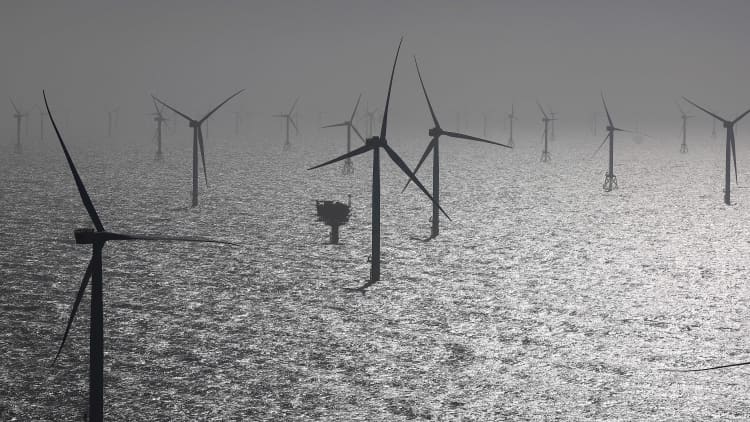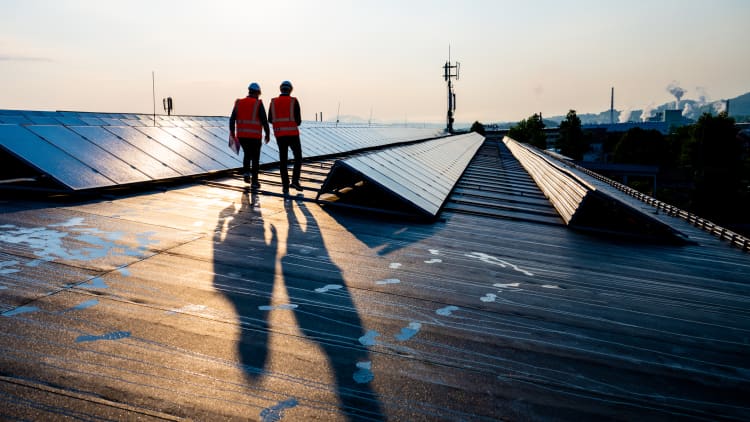A green transition will require trillions of dollars. It’ll be a ‘tall order’ to find the cash, but there’s hope

The growing influence of technologies connected to the energy transition can be seen everywhere, from the increasingly common sight of electric vehicles on our roads to the development of vast renewable energy projects like the Hornsea 2 offshore wind farm.
The shift to a low and zero carbon future will require cutting edge technological innovation alongside huge levels of investment.
The importance of the latter was hammered home during a recent panel discussion moderated by CNBC’s Steve Sedgwick.
“There’s reason for great encouragement in what we’ve seen … [happening] in the last year,” Mark Dooley, global head of Macquarie Asset Management’s Green Investment Group, said.
Referencing the global situation, Dooley added: “We’ve just had our first year, in 2022, where we punched through a trillion dollars going into the energy transition — a trillion dollars.”
“Now, there are plenty of authorities saying that that needs to quickly escalate to $4 trillion, which is a dizzyingly large amount of money … as an annual spend.”
According to the International Energy Agency, clean energy investment will need to hit over $4 trillion a year by 2030 in its Net Zero Emissions by 2050 Scenario.
Reaching this kind of figure will require a huge effort from both the public and private sector, and the stakes are high.
That’s because cutting human-made carbon dioxide emissions to net-zero by 2050 is seen as crucial when it comes to meeting the Paris Agreement’s goal of limiting global warming to “1.5°C above pre-industrial levels.”
The challenge is huge, and the U.N. has noted that 1.5 degrees Celsius is viewed as being “the upper limit” when it comes to avoiding the worst consequences of climate change.
The IEA is not the only organization highlighting the vast amounts of money needed going forward.
Elsewhere, the International Renewable Energy Agency says cumulative investments need to hit $44 trillion by 2030 if we’re to stay on a pathway to 1.5 degrees. What it calls “transition technologies” would account for 80%, or $35 trillion, of this.
As CNBC’s discussion progressed, Dooley broke down where he thought investment would go in the years ahead.
“It’s actually a lot of different categories of activity, drawing on lots of different sources of capital,” he explained.
“A lot of that 4 trillion is grid, is transmission grid, a very large portion of it.”
“A lot of it is individuals choosing to buy electric vehicles and taking other measures,” he later added.
“And yes, a lot of it is about big projects, the kind of thing that lies at the center of the business that I look after.”
“It’s a tall order, but the feeling that we have, the experience we have, is that the investor appetite to be part of this transition is enormous.”
This appetite was there for both established technologies and newer ones, Dooley went on to argue.
“We are very much impressed by the scale of the task in front of us, but there are a lot of very encouraging signs that the money will be there as soon as we can produce … the projects.”

Among those appearing alongside Dooley was Angela Wilkinson, secretary general and CEO of the World Energy Council, a London-based organization established in 1923.
“There is no way you detach the market from politics and energy — ever,” she said. “You don’t just have geopolitics, you have sociopolitics as well … the local politics as well.”
Wilkinson went on to state that, realistically, “we’re going to have to have a blended mix of state and markets working through this — and those are going to take very lumpy forms in different parts of the world.”
Wilkinson also spoke of a “humanizing energy transition” and the importance of moving away from “narratives of fear of the future to enabling more people to see opportunity and benefit for themselves at every level of society.”
“We have technologized this debate, we have financialized this debate, but we have yet to humanize it,” she added.
“And believe me, it’s hundreds of thousands of smaller steps rather than a great big technology leap or a financial leap that’s really going to make the progress.”
For all the latest World News Click Here
For the latest news and updates, follow us on Google News.

